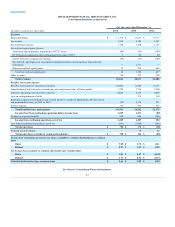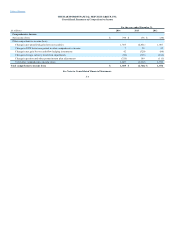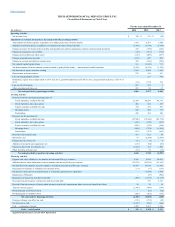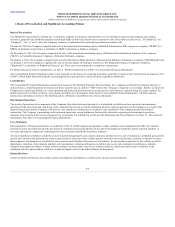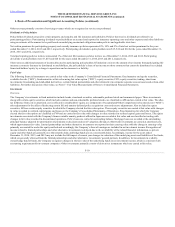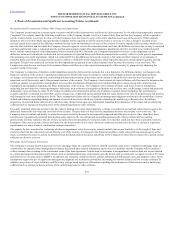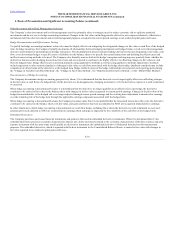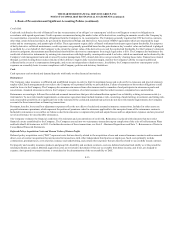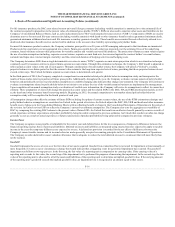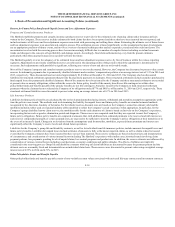The Hartford 2014 Annual Report Download - page 144
Download and view the complete annual report
Please find page 144 of the 2014 The Hartford annual report below. You can navigate through the pages in the report by either clicking on the pages listed below, or by using the keyword search tool below to find specific information within the annual report.
Table of Contents
Amendments to Consolidation Guidance
In February 2015, the Financial Accounting Standards Board ("FASB") issued updated consolidation guidance. The amendments revise existing guidance for
when to consolidate variable interest entities (“VIEs”) and general partners’ investments in limited partnerships, end the deferral granted for applying the VIE
guidance to certain investment companies, and reduce the number of circumstances where a decision maker’s or service provider’s fee arrangement is deemed
to be a variable interest in an entity. The updates also modify consolidation guidance for determining whether limited partnerships are VIEs or voting interest
entities. This guidance is effective for years beginning after December 15, 2015, and may be applied fully retrospectively or through a cumulative effect
adjustment to retained earnings as of the beginning of the year of adoption. The Company will adopt the guidance on January 1, 2016 and has not yet
determined the method or estimated effect of adoption on the Company’s Consolidated Financial Statements.
Revenue Recognition
In May 2014, the FASB issued updated guidance for recognizing revenue. The guidance excludes insurance contracts and financial instruments. Revenue is
to be recognized when, or as, goods or services are transferred to customers in an amount that reflects the consideration that an entity is expected to be
entitled in exchange for those goods or services, and this accounting guidance is similar to current accounting for many transactions. This guidance is
effective retrospectively for years beginning after December 15, 2016, with a choice of restating prior periods or recognizing a cumulative effect for contracts
in place as of the adoption. Early adoption is not permitted. The Company has not yet determined its method for adoption or estimated the effect of the
adoption on the Company’s Consolidated Financial Statements.
Reporting Discontinued Operations
In April 2014, the FASB issued updated guidance on reporting discontinued operations. Under this updated guidance, a discontinued operation will include
a disposal of a major part of an entity’s operations and financial results such as a separate major line of business or a separate major geographical area of
operations. The guidance raises the threshold to be a major operation but no longer precludes discontinued operations presentation where there is significant
continuing involvement or cash flows with a disposed component of an entity. The guidance expands disclosures to include cash flows where there is
significant continuing involvement with a discontinued operation and the pre-tax profit or loss of disposal transactions not reported as discontinued
operations. The updated guidance is effective prospectively for years beginning on or after December 15, 2014, with early application permitted. The
Company will apply the guidance to new disposals and operations newly classified as held for sale beginning first quarter of 2015, with no effect on existing
reported discontinued operations. The effect on the Company’s future results of operations or financial condition will depend on the nature of future disposal
transactions.
The Company’s significant accounting policies are as follows:
Revenue Recognition
Property and casualty insurance premiums are earned on a pro rata basis over the lives of the policies and include accruals for ultimate premium revenue
anticipated under auditable and retrospectively rated policies. Unearned premiums represent the premiums applicable to the unexpired terms of policies in
force. An estimated allowance for doubtful accounts is recorded on the basis of periodic evaluations of balances due from insureds, management’s experience
and current economic conditions. The Company charges off any balances that are determined to be uncollectible. The allowance for doubtful accounts
included in premiums receivable and agents’ balances in the Consolidated Balance Sheets was $131 and $125 as of December 31, 2014 and 2013,
respectively.
Traditional life products' premiums are recognized as revenue when due from policyholders. Group life, disability and accident premiums are generally both
due from policyholders and recognized as revenue on a pro rata basis over the period of the contracts.
Fee income for universal life-type contracts consists of policy charges for policy administration, cost of insurance charges and surrender charges assessed
against policyholders’ account balances and are recognized in the period in which services are provided. Amounts representing account value collected from
policyholders for investment and universal life-type contracts are considered deposits and are not included in revenue. Unearned revenue reserves,
representing amounts assessed as consideration for policy origination of a universal life-type contract, are deferred and recognized in income over the period
benefited, generally in proportion to estimated gross profits.
The Company provides investment management, administrative and distribution services to mutual funds. The Company charges fees to these mutual funds
which are primarily based on the average daily net asset values of the mutual funds and recorded as fee income in the period in which the services are
provided. Commission fees are based on the sale proceeds and recognized at the time of the transaction. Transfer agent fees are assessed as a charge per
account and recognized as fee income in the period in which the services are provided.
F-9





